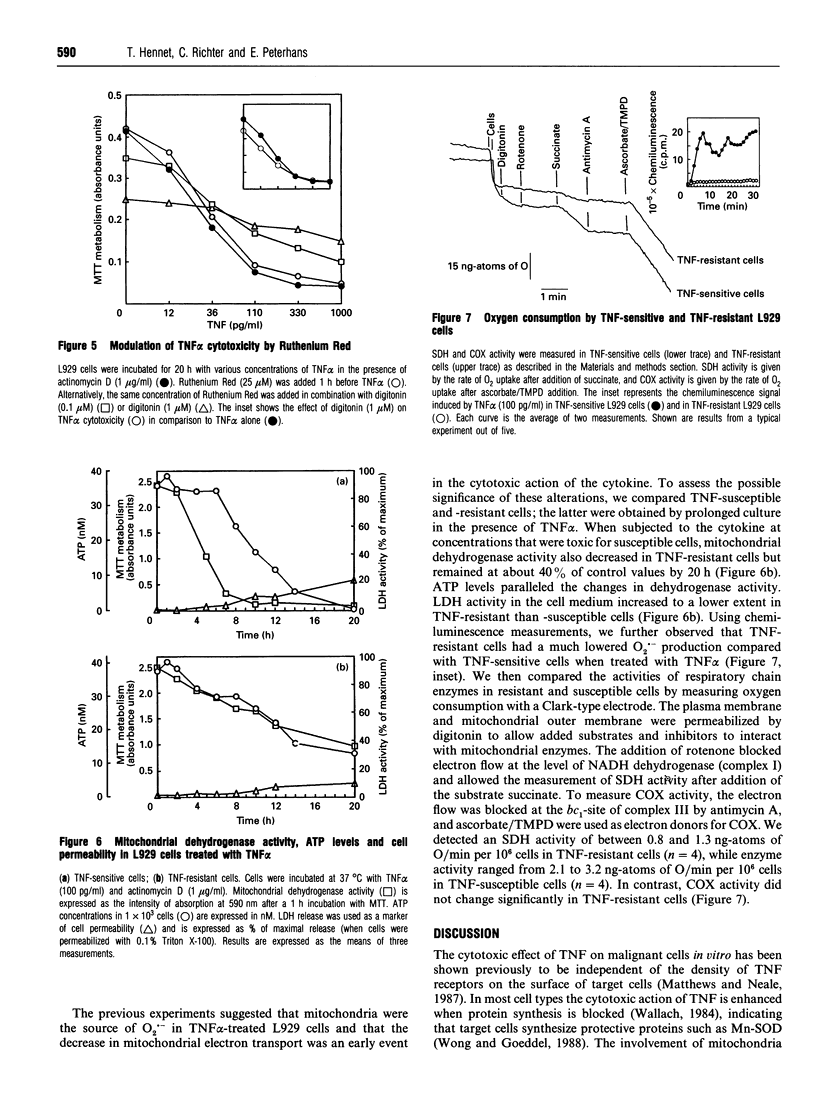Abstract
Within a few minutes after addition to L929 cells, tumour necrosis factor-alpha (TNF alpha) induced an increase in lucigenin-enhanced chemiluminescence that could be inhibited by superoxide dismutase. The generation of superoxide anion (O2.-) was sensitive to treatment with rotenone, antimycin A and cyanide, indicating that the signal originated from mitochondria. The mechanism of production of O2.- was shown to be independent of ATP synthesis, as uncoupling of this event from mitochondrial electron transport did not alter the generation of O2.- induced by TNF alpha. Chemiluminescence was further dependent on the presence of extracellular calcium, suggesting a role for this cation as a second messenger. This hypothesis was supported by the finding that inhibition of mitochondrial calcium uptake by Ruthenium Red exerted a protective effect on TNF alpha-treated L929 cells. Increased O2.- generation was followed by a marked decrease in mitochondrial dehydrogenase activity and cellular ATP levels, while cell membrane permeability was moderately increased. A role for mitochondrial O2.- generation in TNF alpha cytotoxicity was further supported by the finding that resistant L929 cells had decreased ability to produce O2.- in response to TNF alpha. In addition, we detected a decreased activity of the mitochondrial enzyme succinate dehydrogenase in these cells, suggesting that this component of the respiratory chain might be an important contributor to the TNF alpha-induced generation of O2.-.
Full text
PDF





Selected References
These references are in PubMed. This may not be the complete list of references from this article.
- Agarwal S., Drysdale B. E., Shin H. S. Tumor necrosis factor-mediated cytotoxicity involves ADP-ribosylation. J Immunol. 1988 Jun 15;140(12):4187–4192. [PubMed] [Google Scholar]
- Bertoni G., Keist R., Groscurth P., Wyler R., Nicolet J., Peterhans E. A chemiluminescent assay for mycoplasmas in cell cultures. J Immunol Methods. 1985 Apr 8;78(1):123–133. doi: 10.1016/0022-1759(85)90335-7. [DOI] [PubMed] [Google Scholar]
- Carswell E. A., Old L. J., Kassel R. L., Green S., Fiore N., Williamson B. An endotoxin-induced serum factor that causes necrosis of tumors. Proc Natl Acad Sci U S A. 1975 Sep;72(9):3666–3670. doi: 10.1073/pnas.72.9.3666. [DOI] [PMC free article] [PubMed] [Google Scholar]
- Chacon E., Acosta D. Mitochondrial regulation of superoxide by Ca2+: an alternate mechanism for the cardiotoxicity of doxorubicin. Toxicol Appl Pharmacol. 1991 Jan;107(1):117–128. doi: 10.1016/0041-008x(91)90336-d. [DOI] [PubMed] [Google Scholar]
- Chance B., Sies H., Boveris A. Hydroperoxide metabolism in mammalian organs. Physiol Rev. 1979 Jul;59(3):527–605. doi: 10.1152/physrev.1979.59.3.527. [DOI] [PubMed] [Google Scholar]
- De Gómez-Puyou M. T., Gavilanes M., Gómez-Puyou A., Ernster L. Control of activity states of heart mitochondrial ATPase. Role of the proton-motive force and Ca2+. Biochim Biophys Acta. 1980 Oct 3;592(3):396–405. doi: 10.1016/0005-2728(80)90087-0. [DOI] [PubMed] [Google Scholar]
- Denton R. M., McCormack J. G. Ca2+ transport by mammalian mitochondria and its role in hormone action. Am J Physiol. 1985 Dec;249(6 Pt 1):E543–E554. doi: 10.1152/ajpendo.1985.249.6.E543. [DOI] [PubMed] [Google Scholar]
- Granger D. L., Lehninger A. L. Sites of inhibition of mitochondrial electron transport in macrophage-injured neoplastic cells. J Cell Biol. 1982 Nov;95(2 Pt 1):527–535. doi: 10.1083/jcb.95.2.527. [DOI] [PMC free article] [PubMed] [Google Scholar]
- Kagan B. L., Baldwin R. L., Munoz D., Wisnieski B. J. Formation of ion-permeable channels by tumor necrosis factor-alpha. Science. 1992 Mar 13;255(5050):1427–1430. doi: 10.1126/science.1371890. [DOI] [PubMed] [Google Scholar]
- Konstantinov A. A., Peskin A. V., Popova EYu, Khomutov G. B., Ruuge E. K. Superoxide generation by the respiratory chain of tumor mitochondria. Biochim Biophys Acta. 1987 Oct 29;894(1):1–10. doi: 10.1016/0005-2728(87)90206-4. [DOI] [PubMed] [Google Scholar]
- Lancaster J. R., Jr, Laster S. M., Gooding L. R. Inhibition of target cell mitochondrial electron transfer by tumor necrosis factor. FEBS Lett. 1989 May 8;248(1-2):169–174. doi: 10.1016/0014-5793(89)80454-5. [DOI] [PubMed] [Google Scholar]
- Madden E. A., Storrie B. The preparative isolation of mitochondria from Chinese hamster ovary cells. Anal Biochem. 1987 Jun;163(2):350–357. doi: 10.1016/0003-2697(87)90235-1. [DOI] [PubMed] [Google Scholar]
- Matthews N., Neale M. L., Jackson S. K., Stark J. M. Tumour cell killing by tumour necrosis factor: inhibition by anaerobic conditions, free-radical scavengers and inhibitors of arachidonate metabolism. Immunology. 1987 Sep;62(1):153–155. [PMC free article] [PubMed] [Google Scholar]
- Meier B., Habermehl G. G. Evidence for superoxide dismutase and catalase in mollicutes and release of reactive oxygen species. Arch Biochem Biophys. 1990 Feb 15;277(1):74–79. doi: 10.1016/0003-9861(90)90552-a. [DOI] [PubMed] [Google Scholar]
- Meier B., Radeke H. H., Selle S., Younes M., Sies H., Resch K., Habermehl G. G. Human fibroblasts release reactive oxygen species in response to interleukin-1 or tumour necrosis factor-alpha. Biochem J. 1989 Oct 15;263(2):539–545. doi: 10.1042/bj2630539. [DOI] [PMC free article] [PubMed] [Google Scholar]
- Mosmann T. Rapid colorimetric assay for cellular growth and survival: application to proliferation and cytotoxicity assays. J Immunol Methods. 1983 Dec 16;65(1-2):55–63. doi: 10.1016/0022-1759(83)90303-4. [DOI] [PubMed] [Google Scholar]
- Richter C., Frei B., Cerutti P. A. Mobilization of mitochondrial Ca2+ by hydroperoxy-eicosatetraenoic acid. Biochem Biophys Res Commun. 1987 Mar 13;143(2):609–616. doi: 10.1016/0006-291x(87)91397-0. [DOI] [PubMed] [Google Scholar]
- Richter C., Kass G. E. Oxidative stress in mitochondria: its relationship to cellular Ca2+ homeostasis, cell death, proliferation, and differentiation. Chem Biol Interact. 1991;77(1):1–23. doi: 10.1016/0009-2797(91)90002-o. [DOI] [PubMed] [Google Scholar]
- Richter C., Park J. W., Ames B. N. Normal oxidative damage to mitochondrial and nuclear DNA is extensive. Proc Natl Acad Sci U S A. 1988 Sep;85(17):6465–6467. doi: 10.1073/pnas.85.17.6465. [DOI] [PMC free article] [PubMed] [Google Scholar]
- Schmid D. S., Hornung R., McGrath K. M., Paul N., Ruddle N. H. Target cell DNA fragmentation is mediated by lymphotoxin and tumor necrosis factor. Lymphokine Res. 1987 Summer;6(3):195–202. [PubMed] [Google Scholar]
- Schulze-Osthoff K., Bakker A. C., Vanhaesebroeck B., Beyaert R., Jacob W. A., Fiers W. Cytotoxic activity of tumor necrosis factor is mediated by early damage of mitochondrial functions. Evidence for the involvement of mitochondrial radical generation. J Biol Chem. 1992 Mar 15;267(8):5317–5323. [PubMed] [Google Scholar]
- Takeshige K., Minakami S. NADH- and NADPH-dependent formation of superoxide anions by bovine heart submitochondrial particles and NADH-ubiquinone reductase preparation. Biochem J. 1979 Apr 15;180(1):129–135. doi: 10.1042/bj1800129. [DOI] [PMC free article] [PubMed] [Google Scholar]
- Wallach D. Preparations of lymphotoxin induce resistance to their own cytotoxic effect. J Immunol. 1984 May;132(5):2464–2469. [PubMed] [Google Scholar]
- Wong G. H., Elwell J. H., Oberley L. W., Goeddel D. V. Manganous superoxide dismutase is essential for cellular resistance to cytotoxicity of tumor necrosis factor. Cell. 1989 Sep 8;58(5):923–931. doi: 10.1016/0092-8674(89)90944-6. [DOI] [PubMed] [Google Scholar]
- Wong G. H., Goeddel D. V. Induction of manganous superoxide dismutase by tumor necrosis factor: possible protective mechanism. Science. 1988 Nov 11;242(4880):941–944. doi: 10.1126/science.3263703. [DOI] [PubMed] [Google Scholar]
- Zhang Y., Marcillat O., Giulivi C., Ernster L., Davies K. J. The oxidative inactivation of mitochondrial electron transport chain components and ATPase. J Biol Chem. 1990 Sep 25;265(27):16330–16336. [PubMed] [Google Scholar]


